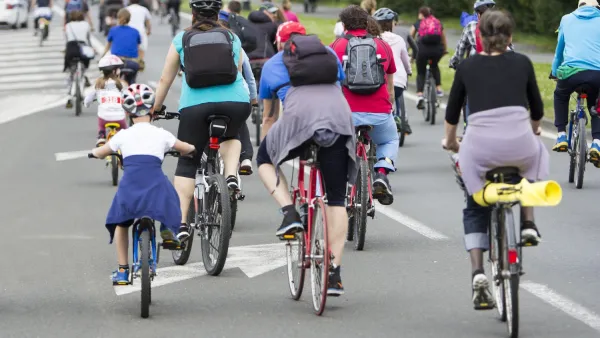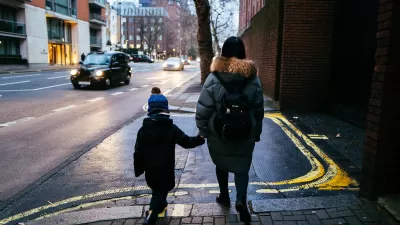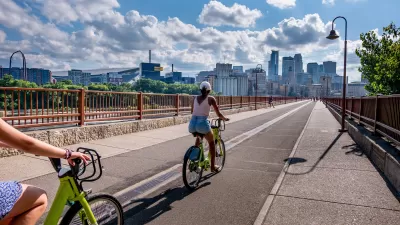A new FHWA report, "Pursuing Equity in Pedestrian and Bicycle Planning" identifies practical ways to achieve social equity by better responding to the active travel needs of currently underserved populations.

The new Federal Highway Administration report, Pursuing Equity in Pedestrian and Bicycle Planning, identifies practical ways to help achieve social equity objectives by examining the travel demands of traditionally underserved populations (low income, minority, older adults, limited English proficiency (LEP) and people with disabilities), and ensuring that pedestrian and bike planning decisions serve those demands.
The report starts with an insightful overview of social equity concepts, including the distinction between equality (treating everybody the same) and equity (responding to people's different needs and abilities), and how these concepts can apply to transportation planning.

The research finds:
- Many traditionally underserved populations often rely on walking and cycling but face significant obstacles in using these modes. For example, many travel by bicycle but are less likely to practice safe bicycling techniques (such as riding with traffic, using lights, and wearing helmets and reflective clothing), and are often forced to ride along roads lacking safe, accessible pedestrian and bicycle facilities.
- Many underserved population groups live where public transit services are limited.
- Many people in the United States, in particular traditionally underserved populations, suffer from problems caused by physical inactivity, which can be addressed through improved access to safe walking and wheeling facilities.
- Women and minorities feel significantly less safe traveling by bicycle than non-minority males in the United States. A majority of women and minorities agreed or strongly agreed that, given more supportive infrastructure (e.g., sidewalks, bike lanes, and separated facilities), they would be much more likely to bicycle for transportation.
- Individuals with limited travel options (including nonmotorized modes) travel less overall, make fewer trips for shopping and socializing; have a harder time applying for and accepting employment; are less likely to access healthy foods, health care, and educational resources; and are more likely to experience social isolation.
The report concludes that pedestrian and bicycle improvements can help reduce transportation inequities. It identifies specific, practical ways to make pedestrian and bicycle planning more responsive to underserved population travel demands, including specific objectives to support social equity goals, new tools for understanding how walking and cycling conditions affect disadvantaged populations' access (such as the number of jobs accessible to disadvantaged groups within an acceptable commute travel time, and how planning decisions would affect this), and more involvement of underserved populations in the planning process. The report also includes examples and case studies of pedestrian and bicycle planning that applies advanced equity analysis.
FULL STORY: Pursuing Equity in Pedestrian and Bicycle Planning

Maui's Vacation Rental Debate Turns Ugly
Verbal attacks, misinformation campaigns and fistfights plague a high-stakes debate to convert thousands of vacation rentals into long-term housing.

Planetizen Federal Action Tracker
A weekly monitor of how Trump’s orders and actions are impacting planners and planning in America.

In Urban Planning, AI Prompting Could be the New Design Thinking
Creativity has long been key to great urban design. What if we see AI as our new creative partner?

Massachusetts Budget Helps Close MBTA Budget Gap
The budget signed by Gov. Maura Healey includes $470 million in MBTA funding for the next fiscal year.

Milwaukee Launches Vision Zero Plan
Seven years after the city signed its Complete Streets Policy, the city is doubling down on its efforts to eliminate traffic deaths.

Portland Raises Parking Fees to Pay for Street Maintenance
The city is struggling to bridge a massive budget gap at the Bureau of Transportation, which largely depleted its reserves during the Civd-19 pandemic.
Urban Design for Planners 1: Software Tools
This six-course series explores essential urban design concepts using open source software and equips planners with the tools they need to participate fully in the urban design process.
Planning for Universal Design
Learn the tools for implementing Universal Design in planning regulations.
Gallatin County Department of Planning & Community Development
Heyer Gruel & Associates PA
JM Goldson LLC
City of Camden Redevelopment Agency
City of Astoria
Transportation Research & Education Center (TREC) at Portland State University
Jefferson Parish Government
Camden Redevelopment Agency
City of Claremont





























